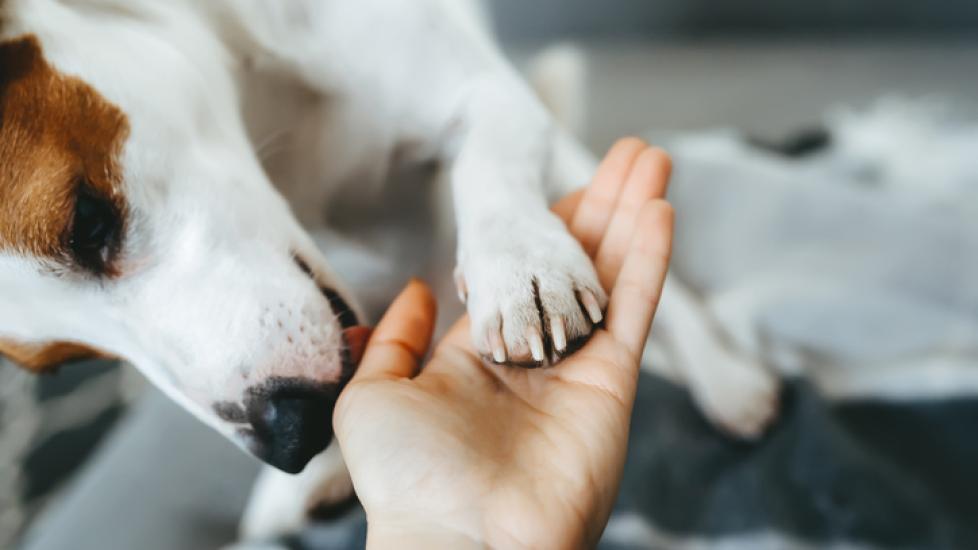Everything You Need to Know About Dog Dewclaws
Take a look at your dog’s feet. How many toenails do you see? Most dogs have four nails on each rear foot and five on their front feet. That extra nail on the upper, inner part of a dog’s foot is the dewclaw.
Did you come up with a different total? Have no fear, some dogs have dewclaws on their rear feet or even double dewclaws. But what, exactly, is a dewclaw, and is it a problem?
What Are Dewclaws?
Dewclaws are essentially the thumbs and big toes of the dog world. They are not directly equivalent to the human structures, of course, but they are similar. Looking at a dog’s front foot, the toes that are in contact with the ground while standing correspond to our pinky, ring finger, middle finger, and index finger. The dewclaw is the “thumb.” The same is true for the canine hind foot with the dewclaw, if it’s present, being the “big toe.”
An important distinction to make is whether or not the dewclaws are firmly attached to a dog’s foot. In general, if your dog has a single front dewclaw, it will be. You’ll be able to wiggle the dewclaw a little bit (mostly in a forward and backward motion), but you can feel the bones and ligaments that connect it to the leg. Rear and double dewclaws tend to only be attached by skin and are much more mobile.
Do Dewclaws Have a Purpose?
A dewclaw that’s attached by bone to a dog’s front foot has a definite purpose. When dogs run, their front feet often bend to the point where their dewclaws contact the ground. At high speeds (especially when turning) or on slippery surfaces, these dewclaws provide extra traction and help stabilize the carpal (wrist) joint.
Some dogs also use their dewclaws to help them climb trees or hold objects to better chew on them. The usefulness of dewclaws that are only attached by skin is less clear.
Should Dewclaws Be Removed?
Because front dewclaws serve several important purposes, they should not be removed unless there is a very good reason to do so. In rare cases, a dog’s dewclaw may be severely injured or develop a disease (such as a cancerous tumor) and removal under those circumstances would be in the dog’s best interests. But these problems occur so infrequently that removing healthy front dewclaws as a preventative measure makes little sense.
Veterinarians will sometimes recommend removing loosely attached double or rear dewclaws to prevent injury. But the actual incidence of these problems is quite low, too, so the value of these surgeries is up for debate. Typically, the procedure is scheduled at the same time the dog is being spayed or neutered.
Some dog breeds routinely have their front dewclaws removed to “improve” their appearance in the show ring. When breeders elect to do so, they should have this procedure performed by a veterinarian when their puppies are under 5 days old and only after the area has been numbed with a local anesthetic. Keep in mind that removing the dewclaws in some breeds, like Great Pyrenees, disqualifies them from the show ring.
Treating Dewclaw Injuries
While dewclaw injuries are relatively rare, they certainly do occur. Any nail can become partially or completely pulled off, broken, split, infected, or ingrown (if not properly trimmed).
Because most nail injuries are extremely painful and prone to infection (think of all the places your dog’s feet have been!), it’s usually best to have them quickly assessed by a veterinarian. They can remove damaged nails or trim ingrown ones (under sedation, if necessary), and prescribe any needed antibiotics and pain relievers.
How to Maintain Dewclaws
When it comes to maintenance, dewclaws are no different from your dog’s other nails. Extremely active dogs may wear down their nails—including their dewclaws—to the point where trims are not necessary. But for most pets, regular nail trims are needed to keep their nails at a healthy length—especially for dewclaws, which aren’t in contact with the ground as frequently as the other nails. Dewclaws may need more frequent trims and, without attention and care, can easily become overgrown.
Featured Image: iStock/IRYNA KAZLOVA
